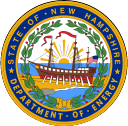Gas
The Department of Energy and the New Hampshire Public Utilities Commission regulate the services and rates of privately-owned natural gas utilities.
The NH Department of Energy regulates two natural gas utilities: Liberty Utilities and Northern Utilities.
Liberty Utilities (EnergyNorth Natural Gas) Corp.
Liberty serves approximately 98,000 gas customers in 30 towns and cities along the Interstate 93 corridor in central and southern parts of the state. Liberty also serves the cities of Berlin and Keene.
Northern Utilities (Unitil), Inc.
Northern serves approximately 35,000 gas customers in 25 communities in the seacoast area of the state.
The gas utilities provide both delivery and supply service to residential, commercial, and commercial-industrial customers, as well as delivery-only (transportation) service to commercial-industrial customers. Of the 130,000 natural gas customers in New Hampshire, 85 percent are residential, 12 percent commercial/commercial-industrial, and 3 percent transportation.
Gas Bills
For most customers, natural gas bills have two main components, delivery costs and commodity costs.
The delivery charge covers costs associated with the delivery of gas through the local utility pipelines (e.g., gas distribution costs, system maintenance, safety and inspection programs, customer service, metering, billing, etc.) and is set by the Public Utilities Commission. The delivery charge is based on reasonable and prudent expenses incurred in providing service and a reasonable rate of return on the utility’s plant investment. It is through the allowed rate of return on plant investment that the utility has the opportunity to earn a profit.
The commodity charge covers the cost associated with gas supply. Gas supply costs include commodity prices (the cost of gas), the cost to transport the gas over the gas pipelines, and storage costs. The utility has little control over the price of natural gas, which is an unregulated commodity. Similarly, the utility has little control over pipeline transportation rates, as those are set by the Federal Energy Regulatory Commission. Also factored into the commodity charge is the cost of both on-system and off-system storage, used to meet winter demand. On-system storage costs are for storage facilities that are owned and operated by the utility and located within its distribution system. Off-system storage costs are the contract costs for use of non-utility owned storage facilities. Utilities do not profit from high gas costs; they may only pass through the actual commodity cost.
How Gas Rates Are Set
The New Hampshire Public Utilities Commission approves gas rates in adjudicative proceedings. The Department of Energy participates as a party in those proceedings and typically files testimony responding to the utilities’ rate requests. A rate case involves an analysis of a utility’s earnings, operations cost and capital investments such as the meters used to measure usage and the underground pipes that deliver gas to homes and businesses, and commodity (gas supply) costs. The law allows a utility to recover the costs of its service as well as a reasonable profit on capital investments used to provide the service. Ultimately, the rates charged to utility customers must be just and reasonable.
Gas utilities are allowed to recoup those gas supply costs that are prudently incurred and used to meet customer requirements. Each gas utility has a gas supply portfolio designed specifically to meet its customer requirements in the most efficient and economical way. The gas utilities are required to dispatch gas from their available supplies on a “least cost” basis. These gas supply costs are then passed on to the customers at the same cost that the gas utilities were charged. The cost of gas rate is set at a level which will allow the gas utility to recover its costs, not to generate a profit.
Commodity charges are initially set using projected costs and sales for the upcoming winter and summer periods. The summer (off-peak) period cost of gas (supply) rate is effective May through October, and the winter (peak) period rate is for November through April. The utility may adjust the commodity charge monthly, within defined parameters which allow the gas utilities to match gas supply costs with gas supply revenues. The adjustments take into account changes in the natural gas market based on actual costs to date and projected costs for the remainder of the period. To the extent that adjustments are based on projected costs, they are subject to reconciliation after actual costs are known, and commodity rates are adjusted accordingly. Any over- or under-collection from a prior cost of gas period is carried forward to the same period the following year.
Gas Rate Volatility
While gas delivery rates are relatively stable, commodity (gas supply) costs can be extremely volatile. Natural gas is an unregulated commodity, and the price is determined by market forces, primarily supply and demand. Normally the winter period supply rates, beginning on November 1st, are noticeably higher than the summer period rates because more costly investments in resources are required to meet winter demand.
Some natural gas consumers follow New York Mercantile Exchange (NYMEX) natural gas commodity futures prices in publications such as the Wall Street Journal or on the web and try to correlate those prices with the gas supply charge on their monthly gas utility bill. Local news organizations may pick up national news stories reporting higher or lower NYMEX prices compared to prior years. Determining the supply rate on your monthly bill is more complicated than a comparison with current NYMEX pricing. There are many factors that can impact your utility’s supply rate that would not be reflected in the NYMEX futures prices.



